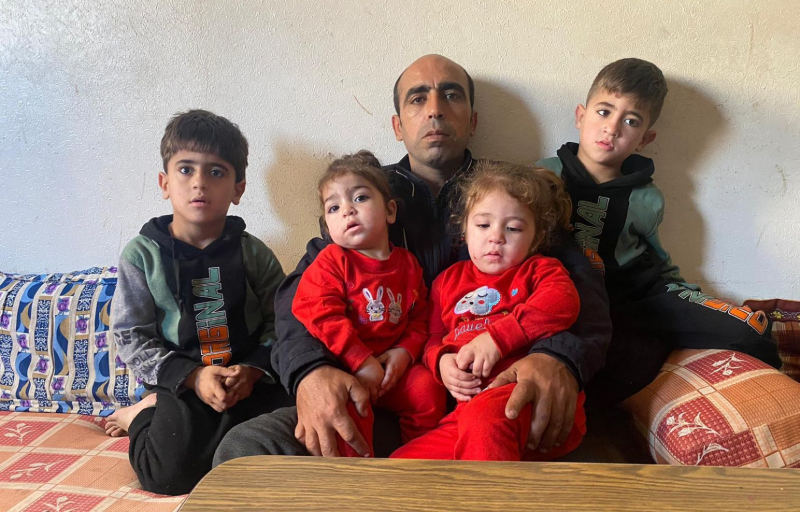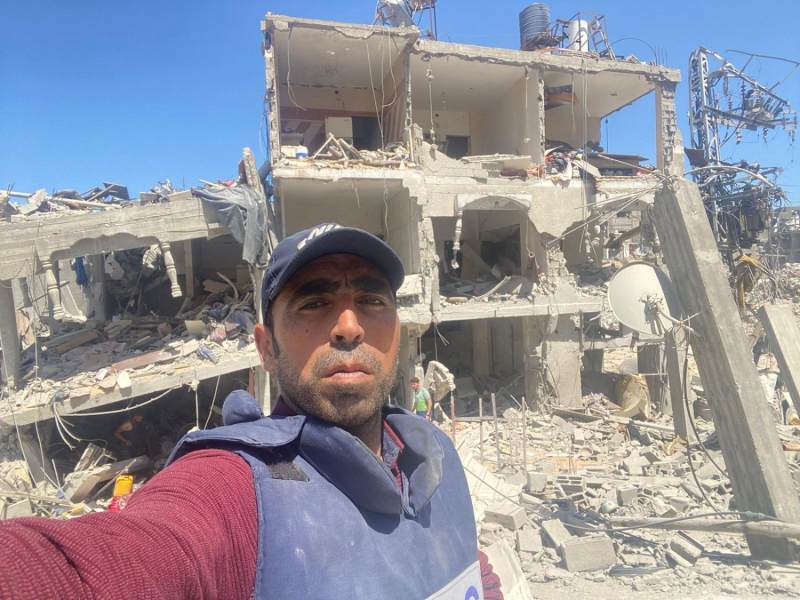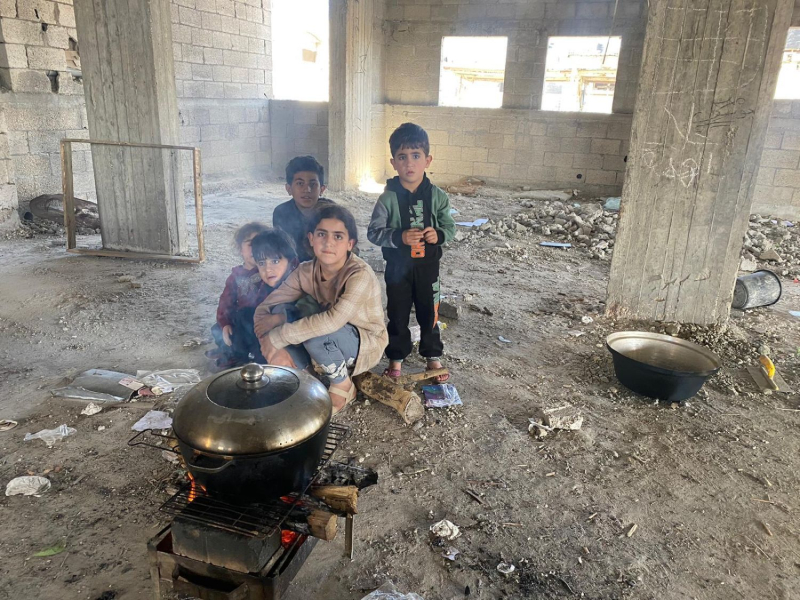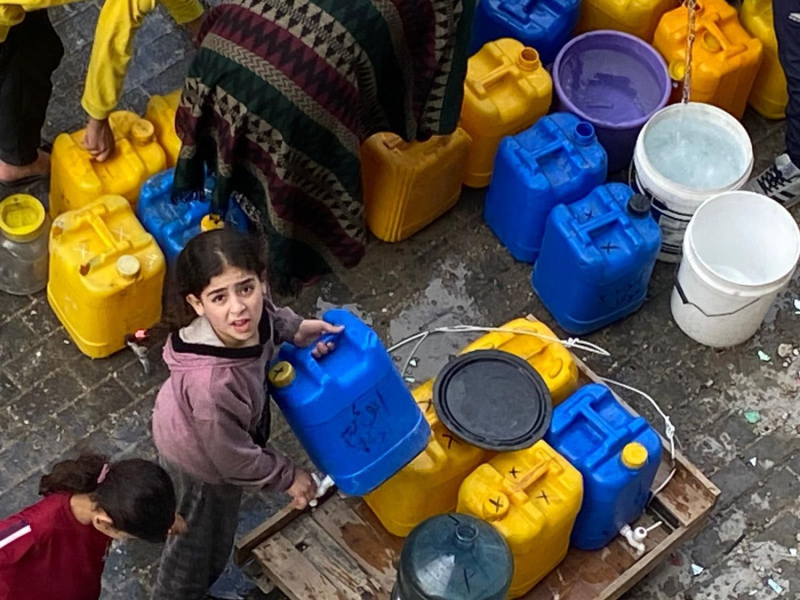
Photo: Photo provided by Abdelhadi Oukal Mohammed Amir Amira Sara and their father
Magdaline Boutros
Posted at 0:00
- Middle East
“I have enough food for a week at most,” says Abdelhadi Oukal, a father of seven who lives in northern Gaza. Since October 2, virtually no humanitarian aid has entered the northern Palestinian enclave, which is under siege by the Israeli army, which is conducting ground and air operations there.
“I have 10 cans of beans, 10 cans of chickpeas, 2 kilos of rice, 2 kilos of lentils and 5 kilos of pasta left,” says the 42-year-old, who is also living under the constant threat of Israeli tanks and aerial bombardments.
Around 200,000 Palestinians are under siege in the northern Gaza Strip, including in the Jabalia refugee camp and in the Beit Hanoun, Beit Lahia and Saftawi areas. In early October, the Israeli army renewed its offensive on the northern part of the enclave, combining ground military operations, airstrikes and evacuation orders.

Photo: Photo provided by Abdelhadi Oukal Abdelhadi Oukal
Israeli authorities have closed all crossings for humanitarian aid. However, three-quarters of the population in the north depends on food aid to survive, according to the United Nations (UN). “We are living on old stocks of aid that we received from local or international organizations,” says Abdelhadi Oukal. “But our reserves are running out.”
The family’s diet is now based mainly on legumes, he says. “As for vegetables, red meat or white meat, we have been deprived of them for a long time,” laments the father, who is also a journalist.

Photo: Photo provided by Abdelhadi Oukal Karim Amir Mohammed and Sara prepare for the meal
All of his children suffered from malnutrition a few months ago, he reports. A situation all the more worrying since his son Karim, 14, suffers from cancer (Burkitt's lymphoma) and another of his sons, Mohammed, 7, has hydrocephalus. “Karim received six doses of chemotherapy in a specialized hospital in the West Bank [before the attacks of October 7, 2023] […], but his medical follow-up has stopped.”
“I fear that if the siege continues, my children will suffer from malnutrition again,” he worries.
On the brink
In a report released Thursday, several UN agencies and non-governmental organizations warned the international community that Gazans are at risk of famine this winter, “unless fighting stops and more humanitarian aid reaches families.”
According to their projections, 345,000 Gazans could face “catastrophic levels of hunger,” 876,000 “emergency levels of hunger,” and 1.95 million (91 percent of the population) “acute levels of food insecurity” in the coming months.
200% Deposit Bonus up to €3,000 180% First Deposit Bonus up to $20,000For Bushra Khalidi, Oxfam’s policy director in the West Bank (another occupied Palestinian territory), “it’s survival every day in Gaza.” Whenever possible, the organization sets up distributions of drinking water, food and hygiene kits, among other things, in the Gaza Strip.
“We would like to do much more,” says the humanitarian worker based in Ramallah. “The needs [of Gazans] are not those of a normal population. This is a population that lives on the brink of death every day.”
Read also
- Le Devoir in Egypt | When Leaving Gaza for Canada is Nearly Impossible
- UN Alarmed by Situation of Children and Safety of Aid Workers in Gaza
- “A Year of Suffering” for Gaza Strip Residents
Reduced Food Self-sufficiency
Food production and economic activities of Gazans have been severely affected by Israeli military operations, she said. Last week, the Al-Shalfouh bakery — the last one still operating in northern Gaza — caught fire after being hit by a strike.
To get bread, families now have to fend for themselves or turn to makeshift bakeries that have sprung up in some neighborhoods. A few bakeries are still open further south, but some have been forced to close due to flour shortages.
As of September 1, 68 percent of cultivated land in Gaza had been damaged, according to an agricultural damage assessment conducted by the Food and Agriculture Organization of the United Nations (FAO) using satellite imagery.

Photo: Photo courtesy of Abdelhadi Oukal Layan at the water distribution
Some 95% of Gaza's cattle, 57% of its sheep, 63% of its goats, 99% of its chickens and 99% of its calves have died, according to the FAO. And some 87% of its fishing boats have been destroyed, not to mention the restrictions imposed by the occupying force on fishing activities. The supply of drinking water is also deficient.
All these shortages are causing prices to skyrocket. “The northern Gaza Strip has certainly become the place where prices are the most expensive in the world,” laments Abdelhadi Oukal. More expensive than in Moscow, Paris and London.”
A tomato—when it is possible to find one—can sell for US$15, and a can of tuna can sell for US$10, he says. A pack of diapers can sell for almost US$100, Bushra Khalidi says.
“Prices change every day in Gaza,” she explains. “It depends on what comes in through the private sector.”
A weapon of war ?
There is no doubt in the eyes of the aid worker that Israel is using hunger as a weapon of war. “It is of course a strategy to use food as a weapon of war,” she condemns. There is plenty of food right next door in Israel, it must be remembered.”
On Wednesday, the head of the UN refugee agency (UNRWA), Philippe Lazzarini, said that “hunger in the Gaza Strip is artificially created.” Similar criticisms have been echoed in several forums this week by the United States, Israel’s main ally.
On Sunday, the Biden administration threatened the Jewish state with suspending part of its military assistance if there was not a significant improvement in the delivery of humanitarian aid within 30 days. Since then, the Times of Israel daily reported that 30 trucks of humanitarian aid entered northern Gaza on Monday, then 50 on Wednesday.
“It’s a drop in the ocean of need,” says Bushra Khalidi. Even in the south, the inflow of humanitarian aid is at its lowest in months, international organizations note.
In an interview published Thursday by the German daily Bild, Israeli Foreign Minister Israel Katz assured that his country does more “than any other country” for its enemies and that Israel is also doing “everything possible to ensure that the international community can provide humanitarian aid to Gaza.”
“The main problem is Hamas [which is behind the October 7, 2023 attacks], which steals humanitarian supplies and sells them to the population, making a lot of money,” he added.
With Mathieu Carbasse

